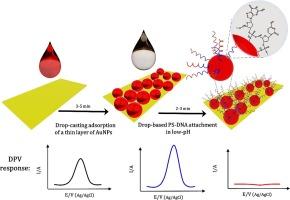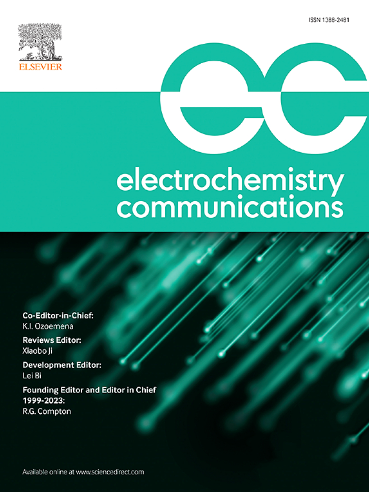A few-minute, simple, and affordable route to functionalized electrodes with DNA
IF 4.7
3区 工程技术
Q2 ELECTROCHEMISTRY
引用次数: 0
Abstract
A key challenge in developing DNA-based electrochemical sensors is the rapid and easy immobilization of DNA on different electrode surfaces. The current methods are often laborious and time-consuming. Here, we present a cost-effective and easy-to-perform method for efficiently functionalizing electrode surfaces with DNA in just a few minutes. Our strategy operates in two simple and rapid steps, regardless of the type of electrode, and avoids complicated and time-consuming procedures. The method uses phosphorothioate (PS) modification as an anchoring agent, which is a more cost-effective alternative to thiol (SH) modification, and eliminates the need for complex pretreatment processes. Additionally, a low-pH DNA loading method was used to quickly bind PS DNA to the gold surface without the need for surface-covering agents. We attributed the effect of low pH to the protonation of adenine (A), which leads to the formation of a parallel poly-A duplex (A motif) and facilitates vertical PS-DNA attachment to the electrode surface. Electrochemical techniques were used to confirm the vertical attachment of DNA to the electrode surface, and evaluation of the adsorption stability and hybridization efficiency confirmed the effectiveness of the method. The simplicity and efficiency of this method make it an ideal solution for researchers who require a fast and reliable method for DNA functionalization of electrode surfaces.

用 DNA 实现功能化电极只需几分钟,既简单又实惠
开发基于 DNA 的电化学传感器的一个关键挑战是如何快速、简便地将 DNA 固定在不同的电极表面。目前的方法往往费时费力。在这里,我们提出了一种经济高效、易于操作的方法,只需几分钟就能用 DNA 高效地功能化电极表面。无论电极类型如何,我们的方法只需两个简单快速的步骤,避免了复杂耗时的程序。该方法使用硫代磷酸酯(PS)修饰作为锚定剂,比硫醇(SH)修饰更具成本效益,而且无需复杂的预处理过程。此外,我们还采用了一种低 pH DNA 负载方法,无需表面覆盖剂即可将 PS DNA 快速结合到金表面。我们将低 pH 值的影响归因于腺嘌呤(A)的质子化,腺嘌呤质子化会形成平行的多 A 双链(A 主题),促进 PS-DNA 垂直附着到电极表面。利用电化学技术确认了 DNA 与电极表面的垂直附着,对吸附稳定性和杂交效率的评估证实了该方法的有效性。该方法简单高效,是研究人员快速可靠地实现电极表面 DNA 功能化的理想解决方案。
本文章由计算机程序翻译,如有差异,请以英文原文为准。
求助全文
约1分钟内获得全文
求助全文
来源期刊

Electrochemistry Communications
工程技术-电化学
CiteScore
8.50
自引率
3.70%
发文量
160
审稿时长
1.2 months
期刊介绍:
Electrochemistry Communications is an open access journal providing fast dissemination of short communications, full communications and mini reviews covering the whole field of electrochemistry which merit urgent publication. Short communications are limited to a maximum of 20,000 characters (including spaces) while full communications and mini reviews are limited to 25,000 characters (including spaces). Supplementary information is permitted for full communications and mini reviews but not for short communications. We aim to be the fastest journal in electrochemistry for these types of papers.
 求助内容:
求助内容: 应助结果提醒方式:
应助结果提醒方式:


